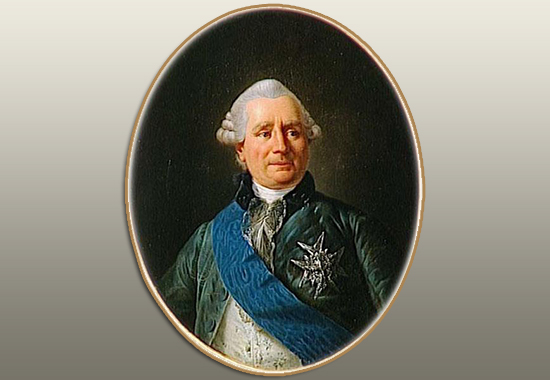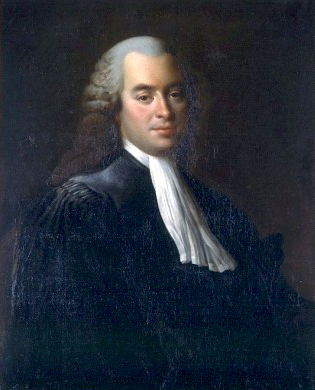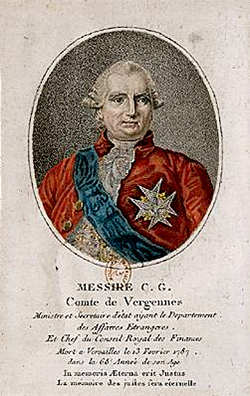|

Charles Gravier, comte de Vergennes
1719-1787
Putting the Rev into the American
Revolution
Vergennes was the French Foreign
Minister from 1774 to his death in
1787.
|
|
Image Above
Charles Gravier, comte de Vergennes, Ministre d'Etat
Oil on canvas by unknown artist
Musée national des
châteaux de Versailles et de Trianon |
Appointed as such by
 King Louis XVI,
Vergennes welcomed the opportunity to scheme against
archrival Britain. This opportunity presented itself in form
of the
King Louis XVI,
Vergennes welcomed the opportunity to scheme against
archrival Britain. This opportunity presented itself in form
of the
 American
Revolution, which was fought 1775-1783. American
Revolution, which was fought 1775-1783.
Vergennes saw to it that money,
military supplies, and eventually manpower reached the
revolutionaries, aiding them in their struggle for
independence from the British.
As it turned out, French support was
crucial to the Colonists' victory.
Vergennes'
Career: The Early Years — 1719-1749
Charles Gravier, count of
Vergennes, was born on December 28, 1719, at
Dijon, France. At the time,
 Louis XV was King of
France (ruled 1715-1774).
Louis XV was King of
France (ruled 1715-1774).
He received basic education at a
Jesuit school.
Vergennes' father was president
of the parlement at Dijon.
His great-uncle was the
French ambassador Théodore
Chevignard de Chavigny.
Wee Charles,
too, chose a career as diplomat and
politician.
1740 -
Worked as his uncle's secretary at
Lisbon.
1743 - Worked as his uncle's secretary at
Frankfurt.
Vergennes was noticed by the
Marquis d'Argenson, Secretary of State for Foreign Affairs
at the time,
and was sent to Treves (Trier) as ambassador.
Vergennes'
Career: Gathering Momentum — 1750-1753
1750 - Ambassador to Trier
1752 - Ambassador to Hanover
Vergennes'
Career: Making an Impact — 1754-1787
::
Ottoman Empire
1754-1768 - Ambassador to
Constantinople, capital of the Ottoman Empire.
1756-1763 -
 Seven Years' War
Seven Years' War
1761 -
Family Compact,
Pacte de
Famille, between France and Spain. Both countries were ruled
by the
 House of Bourbon.
House of Bourbon.
Vergennes' task was to provoke a
war between Russia and the Ottoman Empire. Job
accomplished. Back to Versailles.
1768-1774 -
 Russo-Turkish War
Russo-Turkish War
:: Sweden
1771-1774 - Ambassador to Sweden.
Here, in August 1772, Vergennes supported
 King
Gustav III's bloodless coup against parliament. King
Gustav III's bloodless coup against parliament.
:: France
May 10, 1774 - King
 Louis XV
died and his grandson
Louis-Auguste becomes
Louis XV
died and his grandson
Louis-Auguste becomes
 King
Louis XVI. King
Louis XVI.
June 6, 1774 - The new king appoints
Vergennes as his
Secrétaire d'État aux Affaires étrangères, or Foreign
Minister. Vergennes will hold this position until
his death.
1775-1783 -
 American
Revolution American
Revolution
On May 2, 1776, Louis XVI
decides to send arms and supplies worth one million
livres to the American revolutionaries.
Thus, even before
their Declaration of Independence, Vergennes was
giving French aid to the American revolutionaries by sending weapons and, starting
in May 1776, by sending money.
 Turgot, French
Turgot, French
 Controller General of
Finances, was against this additional expense account.
On May 12, 1776, and not unrelated to the difference of opinion
at hand, Turgot was fired.
Controller General of
Finances, was against this additional expense account.
On May 12, 1776, and not unrelated to the difference of opinion
at hand, Turgot was fired.

Anne Robert Jacques Turgot
© REGION LIMOUSIN.
Service de l’inventaire et du patrimoine culturel.
July 4, 1776 - American
 Declaration of Independence
Declaration of Independence
December 1776 -
 Benjamin
Franklin came over for a visit. He received a
huge welcome, but even the Big B couldn't persuade the French
to officially commit to the cause of the American
revolutionaries just yet. Emphasis on officially. Secret aid
was not a problem.
Benjamin
Franklin came over for a visit. He received a
huge welcome, but even the Big B couldn't persuade the French
to officially commit to the cause of the American
revolutionaries just yet. Emphasis on officially. Secret aid
was not a problem.
Finally, on February 6, 1778,
Vergennes concluded a formal alliance between France and the
Colonists, recognizing the creation of the independent
United States. In fact, two treaties were concluded on this
day. One in case
Britain and France went to war.
Who signed these treaties?
Vergennes sent Secretary of State Conrad
Alexandre Gérard to sign for France. For the
Americans signed their Commissioners
Benjamin Franklin,
Silas Deane, and
Arthur Lee.
In March 1778, the first U.S. consular post
opened in Bordeaux, France.
France declared war on Great Britain on July
10, 1778.
:: Why did the
French keep their support secret for two years?
For one thing,
they waited for Spain to chime in, last but not least because of the
Family Compact from 1761.
What family?
The
 Bourbon family.
Charles
III, who ruled as king of Spain 1759-1788,
was the son of Philip V, born at Versailles in
1683. Philip V was the son of Louis, aka Le
Grand Dauphin, who in turn was the son of a
major gun,
Bourbon family.
Charles
III, who ruled as king of Spain 1759-1788,
was the son of Philip V, born at Versailles in
1683. Philip V was the son of Louis, aka Le
Grand Dauphin, who in turn was the son of a
major gun,
 Louis XIV.
Louis XIV.
Back to the issue.
So, being herself an owner of many
colonies, Spain naturally hesitated to
officially endorse revolutionaries who were
ready to shake off their colonist shackles.
And the other
train of thought was that France wanted to be sure
that the revolutionaries had enough oomph to see it through. If
France put her name on the flags of the American
revolutionaries and their
revolt deflated, France would have a lot of
mopping up to do in the foreign affairs
department.
However, after American
victories in the
 Battles of Saratoga in
September and October 1777, also called the
turning point in the American Revolution,
France decided this horse would win.
So they officially pledged allegiance.
Battles of Saratoga in
September and October 1777, also called the
turning point in the American Revolution,
France decided this horse would win.
So they officially pledged allegiance.
July 3, 1778-1779 -
 War of the
Bavarian Succession. Vergennes was for an
alliance with Austria, but against Austria's annexation of Bavaria. At
the same time, Vergennes was categorically against a French expansion
into the Netherlands.
War of the
Bavarian Succession. Vergennes was for an
alliance with Austria, but against Austria's annexation of Bavaria. At
the same time, Vergennes was categorically against a French expansion
into the Netherlands.
June 1779 - Spain joined France
in the war against Britain. It took a while,
but when it became clear that
Britain refused to let go of Gibraltar, Spain was in.
April 1780 - A French army landed
at Rhode Island. See also
 Lafayette. Lafayette.
July 1780 - League of Armed
Neutrality.
Led by Russian's
 Catherine II,
and joined by Denmark and Sweden against
Britain's habit to search neutral vessels in
the Baltic for contraband, or as some say,
Britain's attempt to blockade other
country's commerce with the American
revolutionaries. Catherine II,
and joined by Denmark and Sweden against
Britain's habit to search neutral vessels in
the Baltic for contraband, or as some say,
Britain's attempt to blockade other
country's commerce with the American
revolutionaries.
When the Dutch toyed with
the idea of joining, Britain declared war, thus making them
a country at war and disqualifying them from joining as a
neutral nation:
December 20, 1780 - Britain declared war on
the Dutch
May 1781 - French naval
assistance was of the essence for the Americans. French Admiral
François-Joseph-Paul de Grasse received orders to sail his
fleet from the West Indies to Chesapeake Bay.
British
Admiral Thomas Graves engaged on September 5, 1781.
This was the
 Battle of Virginia Capes. The French won and
laid the foundation for the victory at the Battle of Virginia Capes. The French won and
laid the foundation for the victory at the
 Siege of Yorktown
in August-October 1781, which ended in Cornwallis' surrender
on October 19, 1781.
Siege of Yorktown
in August-October 1781, which ended in Cornwallis' surrender
on October 19, 1781.
This right here illustrated the
crucial importance of French support in winning the American
Revolution.
September 1783 - Already being Foreign Minister, Vergennes
gets additionally appointed to President of the
Council (Board) of Finance (Conseil des finances).
On September 3, 1783, Vergennes
negotiated peace with Great Britain.
Wrapping up the
American Revolution, he didn't try to gain
territory in North America. Instead he secured Senegal,
including Gorée Island in West Africa and
Tobago and Saint Lucia in the West Indies, and an extension of fishing rights in Newfoundland.
However, he couldn't secure French gains in India.
November 1783 -
 Calonne becomes
Calonne becomes
 controller general of finances.
controller general of finances.
Vergennes was not a fan of
Calonne, especially after Calonne succeeded
in getting the
 Assembly of Notables on its way. Louis agreed
end of November 1786 to assemble the Notables on January 29,
1787.
Assembly of Notables on its way. Louis agreed
end of November 1786 to assemble the Notables on January 29,
1787.
Vergennes joined forces with
Armand Thomas Hue de Miromesnil,
who was the Keeper of the Seals (Garde des Sceaux),
and who also had been against Turgot back in the days.
Together they plotted Calonne's downfall, who was dismissed
in April 1787, a few months after Vergennes' death.
In September 1786, Vergennes
concluded a commercial treaty with England. He wanted to
make nice in order to prevent the war spreading onto the European
continent.
When Austria and Russia designed
to partition the Ottoman Empire, Vergennes was against it.
Vergennes died on February 13,
1787, at Versailles, France.

Messire C.G.
Comte de Vergennes
Colored engraving, 18th century
Bibliothèque Nationale de France
Were the French and the Americans
Really Friends?
In the sense of two countries
being joined by the same goal, absolutely. However, completely
selfless? No such
thing in politics.
The French would have had to fight
Britain with or without American Revolution as a catalyst.
Another motivation was the
prospect of future economic growth, one of the reasons why
France didn't press for territorial gain in North America.
Instead, and in the face of a persistently empty purse, it
seemed more sensible to establish economic ties.
The Statue of Liberty, by the
way, a symbol of friendship between France and the United
States, wasn't dedicated until October 28, 1886.
Vergennes Trivia
The town of Vergennes in
Vermont, established in 1788, was named in honor of Charles
Gravier, comte de Vergennes.

Vergennes -
Vermont's Oldest City
Vergennes City Council
More History
|